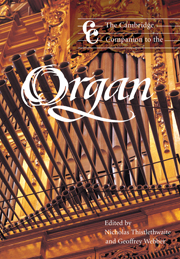9 - Organ music and the liturgy
from Part II - The player
Published online by Cambridge University Press: 28 September 2011
Summary
The organ and liturgy stand in close relationship. The construction of organs in the churches of Western Christendom, and their use in its liturgies, is the phenomenon to which is owed the existence of most of our organ literature. Our critical appreciation of organ music is deeply coloured by a knowledge of the context of its composition and performance, including inevitably the liturgical conditions which gave it purpose and shape. Without such knowledge some of the repertory can be unintelligible, and much of it less rich in significance.
There are obvious reasons why the organ was developed within the context of liturgical buildings and liturgical purpose. In the history of Western civilisation it was the only single instrument capable of providing an adequate level and diversity of sound in large and sometimes acoustically intractable buildings. This is still true today, if we except electro-acoustic options. To produce this mass of sound, it had the advantage of relative ease of operation though not of construction. Its place in ecclesiastical buildings was underwritten by scriptural authority, notably Psalm 150 with its reference to ‘laudate eum in chordis et organo’, whatever the significance of the vulgate term ‘organo’ is against the Hebrew original. As to its desirable effect on the faithful, Cardinal Bona had little doubt: ‘the sound of the organ’, he wrote in his De divina psalmodia (Paris, 1663), ‘brings joy to the sorrowful soul, evokes the happiness of the heavenly city, rouses the lazy, refreshes the watchful, induces love in the just, and brings the sinner to repentance’.
- Type
- Chapter
- Information
- The Cambridge Companion to the Organ , pp. 130 - 147Publisher: Cambridge University PressPrint publication year: 1999
- 1
- Cited by

